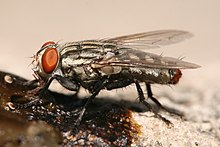Calyptratae is a subsection of Schizophora in the insect order Diptera, commonly referred to as the calyptrate muscoids (or simply calyptrates). It consists of those flies which possess a calypter that covers the halteres, among which are some of the most familiar of all flies, such as the house fly.
| Calyptratae Temporal range:
| |
|---|---|

| |
| Scientific classification | |
| Domain: | Eukaryota |
| Kingdom: | Animalia |
| Phylum: | Arthropoda |
| Class: | Insecta |
| Order: | Diptera |
| (unranked): | Eremoneura |
| (unranked): | Cyclorrhapha |
| Section: | Schizophora |
| Subsection: | Calyptratae |
| Superfamilies | |
About 18,000 described species are in this group, or about 12% of all the flies yet described.[1]
Subsection edit
- Superfamily Muscoidea
- Anthomyiidae - cabbage flies
- Fanniidae
- Muscidae - house flies
- Scathophagidae - dung flies
- Superfamily Oestroidea
- Superfamily Hippoboscoidea
The Mormotomyiidae belong to the Ephydroidea and not to Hippoboscoidea as previously construed.[3] The Streblidae are probably not monophyletic.[4]
References edit
Wikispecies has information related to Calyptrata.
- '^ Kutty, Sujatha Narayanan; Pape, Thomas; Wiegmann, Brian M.; Meier, Rudolf (2010). "Molecular phylogeny of the Calyptratae (Diptera: Cyclorrhapha) with an emphasis on the superfamily Oestroidea and the position of Mystacinobiidae and Mc Alpines fly". Systematic Entomology. 35 (4): 614–635. doi:10.1111/j.1365-3113.2010.00536.x.
- ^ Michelsen, Verner; Pape, Thomas (2017). "Ulurumyiidae – a new family of calyptrate flies (Diptera)". Systematic Entomology. 42 (4): 826–836. doi:10.1111/syen.12252. S2CID 90058240.
- ^ Kirk-Spriggs, A.H., Kotrba, M. & Copeland, R.S. 2011. Further details of the morphology of the enigmatic African fly Mormotomyia hirsuta Austen (Diptera: Mormotomyiidae). African Invertebrates 52 (1): 145-165."Archived copy". Archived from the original on 2011-10-04. Retrieved 2011-10-04.
{{cite web}}: CS1 maint: archived copy as title (link) - ^ Petersen, Frederik Torp; Meier, Rudolf; Kutty, Sujatha Narayanan & Wiegmann, Brian M. (2007): The phylogeny and evolution of host choice in the Hippoboscoidea (Diptera) as reconstructed using four molecular markers. Mol. Phylogenet. Evol. 45(1): 111–122. doi:10.1016/j.ympev.2007.04.023 (HTML abstract)